Manuscript accepted on : February 16, 2011
Published online on: 28-06-2011
Haritha Meruvu and Meena Vangalapati*
Center for Biotechnology, Department of Chemical Engineering, College of Engineering, Andhra University, Visakhapatnam - 530 003 India.
ABSTRACT: Protease enzyme is commercially produced by the cultivation of Bacillus subtilis through solid state fermentation using black gram husk which an agricultural waste of low economic value. The production rate is augmented by using carbon and nitrogen supplements like maltose and ammonium chloride. The reaction was carried out by optimizing various physico chemical parameters. The present study reveals that maximum protease enzyme was produced at incubation time 24 hrs, temperature 27oC, moisture content 40% w/v, inoculum level of 2 % w/v, and with substrate concentration of 10 g, pH 7.0, maltose concentration 1.5 % w/w and ammonium chloride concentration 2% w/w with a yield of 693.4 U/ml.
KEYWORDS:
Protease; SSF(solid state fermentation); Bacillus subtilis; physico chemical parameters
Download this article as:| Copy the following to cite this article: Meruvu H, Vangalapati M. Critical Studies on Physico-Chemical Parameters for the Production Of Protease Through SSF With Bacillus Subtilis NCIM 2724 Using Black Gram Husk As Substrate. Biosci Biotech Res Asia 2011;8(1) |
| Copy the following to cite this URL: Meruvu H, Vangalapati M. Critical Studies on Physico-Chemical Parameters for the Production Of Protease Through SSF With Bacillus Subtilis NCIM 2724 Using Black Gram Husk As Substrate. Biosci Biotech Res Asia 2011;8(1). Available from: https://www.biotech-asia.org/?p=9311 |
Introduction
Protease is an enzyme that conducts proteolysis, begins protein catabolism by hydrolysis of the peptide bonds that link amino acids together in the polypeptide chain6. Microbial proteases account to approximately 40% of the total worldwide enzymes sale2. In addition, proteases from microbial sources are preferred to the enzymes from plant and animal sources since they possess almost all characteristics desired for their biotechnological applications7.In the present work black gram husk is selected as an apt substrate as it is easily available and is of minimal commercial interest being an agricultural waste11. Moreover it has a suitable texture for solid state fermentation12.Moreover it has 57% proteolytic activity. Here we optimize various physico chemical parameters needed for the production of protease enzyme by Bacillus subtilis.
Experimental
Material and Methods
Microorganism used is Bacillus subtilis (NCIM 2724), procured from NCIM, Pune. The culture was maintained on nutrient agar medium slant and subcultured for every 21 days8. The maintenance medium used for sub culturing is nutrient agar medium with composition , Yeast Extract 1.5 g/l, Beef extract 1.5 g/l, NaCl 5.0 g/l, Peptone 15.0 g/l, Agar 5.0 g/l.
Preparation of Inoculum
Inocula are prepared by transferring 2ml of suspension from 24 hour old slant culture into 250 ml Erlenmeyer flasks containing production substrate. Substrate used is Black gram husk which is an agricultural waste10. Commercial quality of black gram husk was procured from the local market and used as the solid substrate for the production of protease. It is added with minimal moisture content and autoclaved at 1210C and 12 lb pressure for 20 minutes to sterile it as well as to soften the hard texture so as the microbe digests the husk easily yielding optimal enzyme production12.
Fermentation procedure
The basic protocol observed for solid state fermentation with standard values is as follows. Certain amount of substrate was taken in 250 ml Erlenmeyer conical flasks and to this, moisture content was added. The contents were mixed thoroughly and autoclaved at 1210C for 15 min. After cooling the flasks to room temperature, the flasks were inoculated with grown culture strain under sterile conditions. The inoculum was prepared by adding sterile distilled water to a culture slant. The contents were mixed thoroughly and incubated in a slanting position to provide maximum surface area at required temperature.This procedure was followed individually for all parameters by varying, the incubation time from 12 hrs to 96 hrs, temperature 24 oC to 36 oC, moisture content 20% w/v to 60% w/v, inoculum level of 1.0 % w/v to 3.0
% w/v, and with substrate concentration of 6g to 12 g, pH 6.0 to 10, maltose concentration 0.5% w/w to 3.0% w/w and ammonium chloride concentration 0.5% w/w to 3.0 % w/w, to find out the optimal levels of the respective parameters.
Enzyme extraction
After incubation period, the enzyme was extracted by adding 50 ml of 0.2 M glycine – NaOH buffer at pH 10,this is kept for shaking in an orbital shaker for 30 min11. Then the mixture was filtered using a Whattmann No. 1 filter paper. The extracts were collected and then centrifuged. The supernatant was used as enzyme source for protease.
Enzyme assay
Alkaline protease activity was estimated by the modified Auson – Hagihara Method,1.0 mL of the enzyme solution was added to 6.0 ml of casein and the mixture was incubated at 370C for 10 min. Then 6.0 ml of TCA (Trichloroacetic acid) was added and incubated for 30 min at room temperature,the mixture was centrifuged for 10 min;2 ml of Folin-Ciocalteaue reagent was added to the 1 ml of the supernatant taken and incubated
for 30 min at room temperature. Then the absorbance was read at 660 nm.
Results and Discussion
Effect of incubation time on protease enzyme production
The cultures were incubated under proper conditions at different time intervals viz., 12, 24,48,72,96 hours were used to investigate the influence on protease enzyme production. It was observed that there is a steep increase in the protease enzyme production with an increase in time of incubation showing maximum at 24 hrs, with continuous increase in biomass concentration and simultaneous decrease in the substrate level as shown in Figure1.
Effect of temperature
The exter nal temperature shows a significant effect on the cell growth, metabolism and thereby the production of itaconic acid. Bacillus subtilis was found to grow in the temperature range of 24°C, 27°C, 30°C, 33°C, 36°C. Fig. 2 shows the influence of temperature on protease activity; here a slight increase in protease activity is noticed and a highest is seen at 27°C, then there is drastic decrease up to 33°C.
Effect of moisture content
Moisture content or water activity is one of the most critical factors influencing protease production in solid state fermentation. To determine the moisture content effect on the production media, the different moisture content has been used i.e., 20%, 30%, 40%, 50% and 60 % and the optimum was recorded at 40%. Figure 3 shows the influence of variation in moisture content on the protease enzyme production. Here as the moisture content increases the protease activity increases and a maximum is noticed at 40%, then it gradually falls to 50% and then 60%.
Effect of inoculum level
To evaluate the effect of inoculum level on the protease production varying cell concentration were added to different flasks. Different inoculum levels of 1.0, 1.5, 2.0, 2.5, and 3.0 were added to the production medium and kept in incubator for 24 hours and the maximum activity was observed at
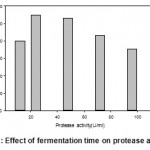 |
Figure 1: Effect of fermentation time on protease activity.
|
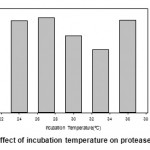 |
Figure 2: Effect of incubation temperature on protease activity.
|
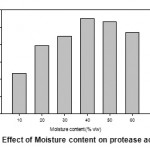 |
Figure 3: Effect of Moisture content on protease activity.
|
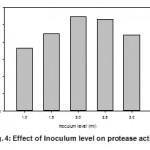 |
Figure 4: Effect of Inoculum level on protease activity.
|
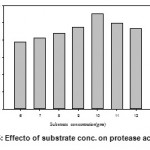 |
Figure 5: Effecto of substrate conc. on protease activity.
|
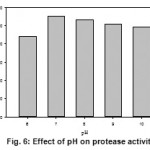 |
Figure 6: Effect of pH on protease activity.
|
2.0 ml.Here the Figure 4 shows the steady increase in protease activity, reaching a maximum at 2.0 ml of inoculum per 10 grams of substrate used. Later we observe a steep decrease near 2.5 ml and again the protease activity falls, because of increase in the bacterial count which augments the want for nutrients however that is not met by the depletion in nutrients.
Effect of substrate concentration
To deter mine the effect of substrate concentration on protease production, the production medium of different concentrations of 6 gms, 7 gms, 8, gms, 9 gms, 10 gms, 11 gms, 12 gms are prepared in 250 ml flasks and each flask in inoculated. The results indicate that the enzyme activity gradually increased and was found to be
highest at 10 grams. The Figure 5 shows a gradual increase in enzyme activity to the peak at 10gms and a decline after that.
Effect of pH
To determine the effect of pH on enzyme production, the production medium was adjusted to different pH such as 6.0, 7.0, 8.0, 9.0, 10.0. These flasks were incubated for 24 hours and the enzyme activity was found maximum at pH 7.0. The steep curve shown in the Figure 6 indicates the gradual increase in enzyme activity and a later fall; hereby the protease activity is found to be maximum at neutral pH.
Effect of Maltose
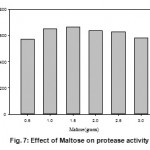 |
Figure 7: Effect of Maltose on protease activity.
|
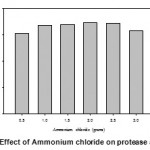 |
Figure 8: Effect of Ammonium chloride on protease activity.
|
supplement maltose on enzyme production, the production medium was added with levels of maltose such as 0.5, 1.0, 1.5, 2.0, 2.5, 3.0. These flasks were incubated for 24 hours and the enzyme activity was a maximum of 694.4 U/ml at 1.5 gmsGraph 7 shows the influence of variation in maltose on protease production. Here there is an increase and a haphazard decrease of protease activity in a variable fashion. The highest protease activity is observed at 1.5 gms of maltose taken as supplement to 10gms of substrate.
Effect of ammonium chloride
To determine the effect of the nitrogen supplement ammonium chloride on enzyme production, the production medium was added with levels of maltose such as 0.5, 1.0, 1.5, 2.0, 2.5,
3.0. These flasks were incubated for 24 hours and the enzyme activity was found to be maximum of
694.4 U/ml at 2.0 gms. Figure 8 shows the influence of variation in Ammonium chloride on protease production. Here there is an increase and a haphazard decrease of protease activity in a variable fashion. The highest protease activity is obser ved at 2.0 gms of maltose taken as supplement to 10gms of substrate.
Conclusion
In conclusion we have reported the effects of a vivid number of physico chemical parameters, like fermentation time, incubation temperature, moisture content, inoculum level, substrate concentration, pH, carbon and nitrogen supplements upon protease enzyme production from black gram husk by Solid state fermentation using Bacillus subtilis. While analyzing the parametric changes, the proteolytic activity of the enzyme is found to augmented to a certain level, reaches an optimal value and then starts decreasing gradually. Hereby, it can be found that enzymes are active at particular optimal conditions and such conditions for optimal protease production from Black gram husk using Bacillus subtilis through Solid state fer mentation are elucidated. Maximum protease enzyme production of 549.36U/ml was observed at an incubation time 24 hrs, temperature 27oC, moisture content 40% w/v, inoculum level of 2 % w/v, and with substrate concentration of 10 g, pH 7.0.With addition of a glucose supplement, maltose concentration 1.5 % w/w it was increased to 666.69 U/ml and augmentation with nitrogen supplement, ammonium chloride concentration 2% w/w gives a yield of 693.4 U/ml.
References
- V. Meena, Biosciences, Biotechnology Research Asia , 7(1): 259-266 (2010).
- Anthonsen T, Reactions Catalyzed by Enzymes. Applied Biocatalysis, 2nd Ed. 5–18 (1999).
- 3. Asimov Isaac, A Short History of Biology. The Natural History, 7th 95–99 (1994).
- Athel Cornish-Bowden, New Beer in an Old Bottle: Edward Buchner and the Growth of Biochemical Knowledge. A history of early Enzymology, 2nd Ed. 45–98 (1970).
- Barrett A J, Rawlings N D, Woessner J F, The Handbook of Proteolytic Enzymes, Academic Press, 2nd Ed. 101–163 (2003).
- Beynom R J, Bond, J S, Proteolytic enzymes: A practical approach. Enzymology, .7 (2003).
- Cannel E and Moo-Young, Solid-state fermentation Process Biochem. 15: 58–83 (1999).
- Cohn F, Early studies on Bacillus subtilis, Science of Microbes, 1: 127-224 (1972).
- Ehrenberg C G, Physiology of Bacillus subtilis, Bioscience., 8: 145-336 (1995).
- Ellaiah P, Srinivasulu B, Adinarayana K, A Review on microbial proteases, Enzyme , 3: 690–704 (2002).
- Heinicke RM & W A Gortner, Stem A new protease preparation from pineapple plants, Econ. Bot, 11: 225–234 (2004).
- Jeswani, M. and Baldev, B., Advances in Pulse Production Technology, Indian Council of Agricultural Research Publication, 2: 267– 295 (1988).
- Nakano M M, Zuber P,Anaerobic growth of a strict aerobe (Bacillus subtilis), Annu Rev Microbiol. 52: 165-190 (1998).

This work is licensed under a Creative Commons Attribution 4.0 International License.





